“Lviv should be proud of its Philharmonic and rejoice that this truly artistic institution has put it among the first musical cities in Europe.”
Jan Skrzydlewski [1]
The Myroslav Skoryk Lviv National Philharmonic is an artistic centre in the centre of an ancient European city and one of the leading cultural institutions in Ukraine!
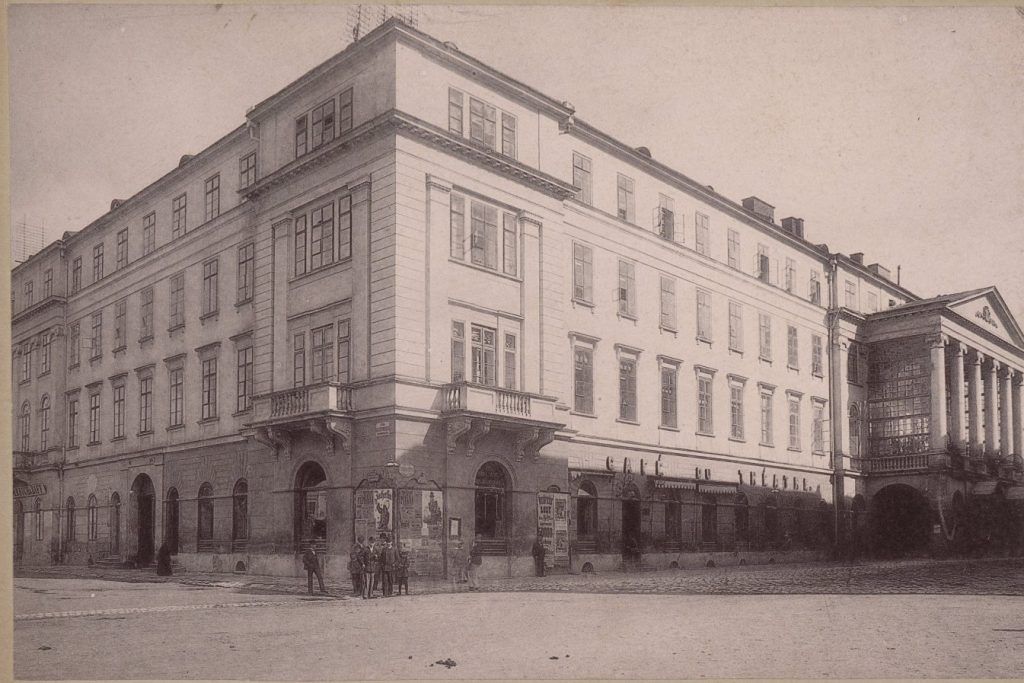
Театр Скарбка на поч. ХХ ст. (з 1902 р. – Львівська філармонія)
The Lviv Philharmonic was inaugurated on 27 September 1902 in the Count Stanisław Skarbek Theatre, which was specially redesigned for the Philharmonic’s needs (today the building is home to the Mariia Zankovetska National Academic Ukrainian Drama Theatre). It was an excellent venue for public performances, as it had 1095 seats, a large moving stage (160 square metres), a concert organ, electric lighting, central heating, and fountains, a cafeteria, a restaurant, and a winter garden.
The Lviv Philharmonic began its activities alongside the philharmonic societies and orchestras of Prague (1901), Warsaw (1901), Stockholm (1902), and Madrid (1903). The new musical location of the city was organised on the initiative of Ludwik Heller, Ludwik Czelansky and Henryk Jarecki.
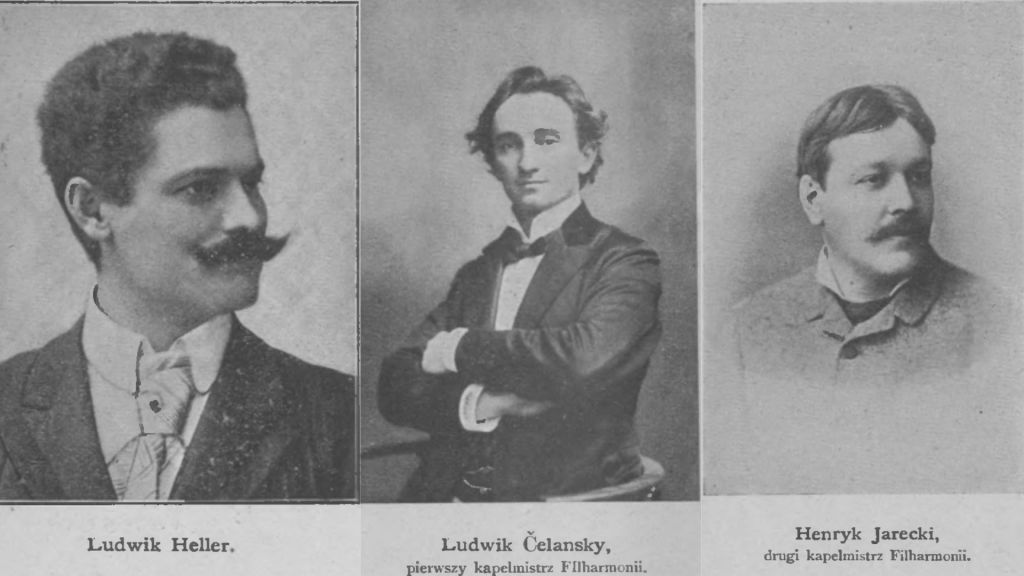
Перші керівники філармонії (зліва направо): директор – Людвік Геллєр, головний дириґент оркестру – Людвік Челянський, другий дириґент – Генрик Ярецький
The event was extremely important for Lviv, as evidenced by the great attention paid to the Philharmonic. The opening brought together a wide range of people: representatives of local authorities, the church, the press, the nobility, intellectuals, and ordinary people. Many congratulatory telegrams and prominent guests from Warsaw and Europe attest to the great public response to the event and its cultural significance not only for Lviv but for the whole of Galicia. At 8 a.m., a solemn service was held in Lviv’s Archdiocesan Cathedral, and at 11 a.m., the newly renovated hall began to gather spectators. The three inaugural concerts on 27, 28 and 29 September were attended by a huge number of people.
The establishment of a new concert organisation in Lviv in 1902 contributed to the popularisation of symphonic music, as a specially created Philharmonic Symphony Orchestra became an integral part of the institution, which met the requirements of the time in terms of its professional level and performed both classical repertoire and the latest works of its time.
Its organisation was a matter of principle and paramount importance for the Philharmonic Directorate. To this end, L. Heller made many efforts, and the well-known Lviv conductor L. Ćelansky was involved in the organisation of the orchestra and the selection of personnel.
When Ludvik Vitezslav Ćelansky (1870-1931) became the chief conductor, he assembled a highly professional team of 68 people, the vast majority of whom were graduates of the Prague Conservatory. Alongside him at the conductor’s console were Henryk Jarecki (1846-1918) and Henryk Meltzer.
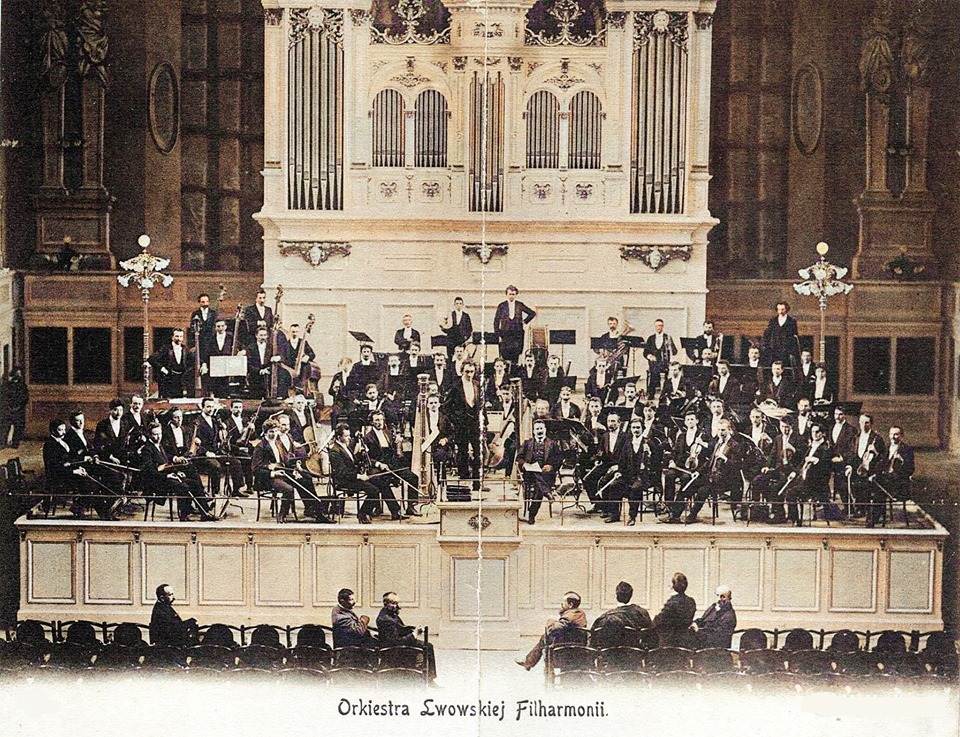
Симфонічний оркестр Львівської філармонії (1902-1903 рр.)
The orchestras and conductors began working 20 days before the opening of the Philharmonic: the first rehearsal was scheduled for 8 September 1902, and they took place daily from then on.
Before the start of the season, the Lviv Philharmonic management announced performances by famous European singers and musicians at least once a week, 2 popular concerts, 1 symphonic concert, receptions, promenade concerts, and carnival redoubts. The possibility of renting the hall for balls, amateur theatre performances and charity events was also considered. During the season, which was to last until 15 May 1903, it was planned to hold 120 concerts. In particular, 30 grand symphony concerts, 30 ordinary symphony concerts and 60 popular concerts.
During the first season, the orchestra performed over 128 concerts (including 68 large symphony concerts with soloists, 34 popular concerts, 18 symphony concerts, and 8 composer concerts), and the total number of visitors exceeded 115 thousand people! Over 700 pieces of music of various genres were performed during the season alone. The concert programmes included almost all symphonies by Ludwig van Beethoven, symphonic works by Felix Mendelssohn, Wolfgang Amadeus Mozart, Franz Schubert, Robert Schumann, Franz Liszt, Antonín Dvořák, Anton Bruckner, Gustav Mahler, Camille Saint-Saëns, Piotr Tchaikovsky, Richard Strauss and many others.
During the first season, dozens of world-class musicians performed on the stage of the Lviv Philharmonic: vocalists – Gemma Bellincioni, Iryna Bogus-Geller, Mira Geller, Yanina Korolevich, Solomiia Krushelnytska, Viktor Grombchevskyi, Emma Holmstrand, Regina Pinkertuvna, Zelma Kurtz, Maria Leval, Oleksandr Bandrovskyi, Oleksandr Bonchi, Oleksandr Myshuga, Franciszek Naval, Mykola Rothmul, Maria Sammarco;pianists: Severin Eisenberger, Ignacy Friedman, Leopold Godowski, Józef Hoffmann, Mieczysław Gorszowski, Helena Morsztynówna, Henryk Melzer, Józef Sliwinski, Sigmund Stojowski, Janina Blomfeld, Teresia Carreno-Tagliapietra, Bertha Marx-Goldschmidt, Silnio Ruegari, Maurice Rosenthal;violinists – Stanislav Bartsevich, Willie Burmester, Bronislaw Huberman, Jaroslav Kocijan, Amalia Heller, Artur Argiewicz, Jan Kublik, Mieczyslaw Natrowski, Emil Sore, Franciszek Ondřicek, Pablo Sarasate, Bianca Pantheo, Eugène Izai;cellist Sigmund Burger; organist Edward Tregler; conductors and composers Sigmund Noskovsky, Richard Strauss, Władysław Żelenski, Lorenzo Perosi, Ruggero Leoncavallo, Mieczysław Karłowicz, Gustav Mahler; the Soldat-Reger Quartet, etc.
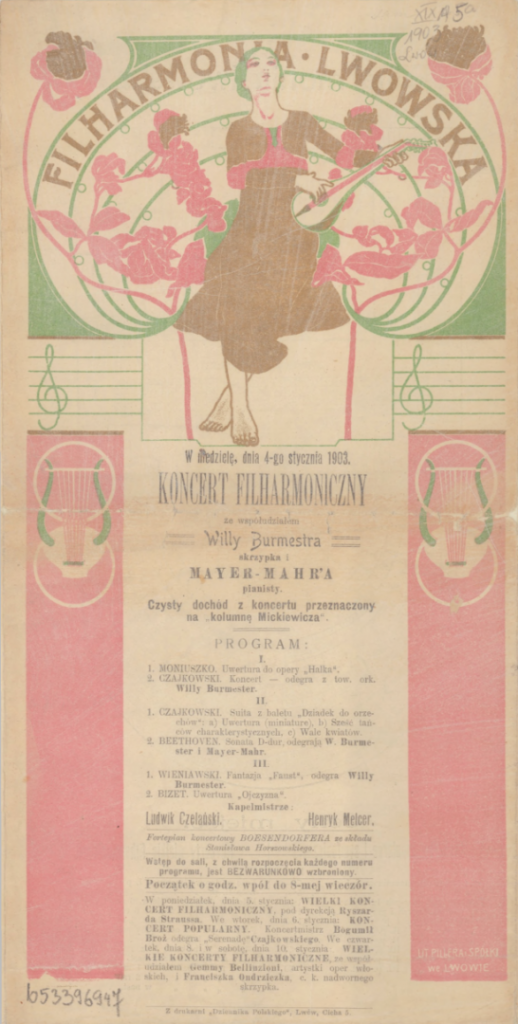
Афіша концерту першого сезону Львівської філармонії
After the end of the brilliant season, L. Heller, together with L. Ćelansky, organised an opera and philharmonic company, attracting the best soloists (among them were S. Krushelnytska, O. Myshuha, A. Didiura, and others) and went on tour. Performances were scheduled in Krakow, Warsaw, Lodz, Vilna, Kharkiv, Kyiv, Odesa, St. Petersburg, and Moscow. Having received a refusal from the management of the Lviv Opera House to let the choir go on tour, Heller engaged the choir from the La Scala Theatre for the entire summer. However, the musicians did not manage to visit all the planned locations: during the tour, the orchestra faced financial difficulties due to the fact that the entrepreneur cancelled the contract with the group. The musicians tried to continue the tour on their own and performed in Vitebsk, Liepaja, and St. Petersburg. However, the money they earned was barely enough to return to Lviv. After the unsuccessful tour, Chelyansky’s orchestra performed twice more at the Philharmonic, and then quit to exist. For a long time, the Lviv Philharmonic did not have its own orchestra.
The new philharmonic season began on 29 October 1903, and Leopold Litynskyi (1867-1906) became the new director of the institution. The latter attempted to create such a collective from among the best musicians of the military orchestras of several local infantry regiments, who continued the Philharmonic’s concert activities in 1903-1904. From that moment on, the Lviv Philharmonic continued its activities as a concert organisation, organising performances by touring orchestras and various chamber concerts.
In the following years, Lviv was primarily host to touring orchestras, including the Tonkünstler Orchestra of Vienna conducted by Oskar Nedbal (1909, 1910, 1911, 1913, 1918) and the symphony orchestras of the Vienna Music Society (1908), The Munich Philharmonic under Austrian conductor Ferdinand Löwe (1909), the Warsaw Philharmonic under Zdzislaw Birnbaum (1912), the Czech Philharmonic under Wilhelm Zemanek (1913), and many others.
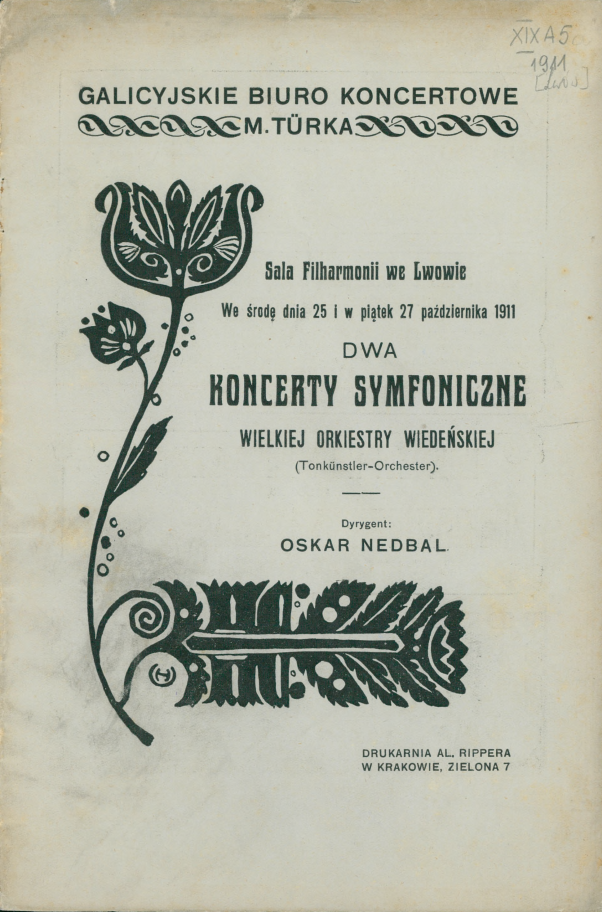
Афіша концерту віденського оркестру (1911)
Ukrainian music was also performed in the early years of the Lviv Philharmonic. In particular, on 27 April 1903, the world-famous Ukrainian singer Solomiia Krushelnytska gave a recital, and on 6 May 1903, the Philharmonic Orchestra performed the overture to Mykola Lysenko’s opera A Christmas Carol and the Ukrainian Capriccio by the young S. Liudkevych under the trampoline of L. Ćelansky (the premiere of the work!). In December 1903, the 35th anniversary of Mykola Lysenko’s creative activity was celebrated in the Lviv Philharmonic Hall (S. Krushelnytska also took part in it), and on 2 March 1909, a concert in memory of Taras Shevchenko was held. In 1911, the 100th anniversary of Markiian Shashkevych’s birth was celebrated in the Philharmonic Hall on a large scale. The event took place on 6 November with the participation of the military orchestra of the 15th Infantry Regiment led by Konopasek, the mixed choir “Boian”, the choir of the Ukrainian Theological Seminary, S. Krushelnytska, and Czech violinist F. Krebs. Compositions by S. Liudkevych, V. Matiuk, M. Lysenko, O. Nyzhankivskyi, J. Lopatynskyi, J. Wintskowski, A. Vakhnyanyn, A. Wedel, R. Wagner, and others.
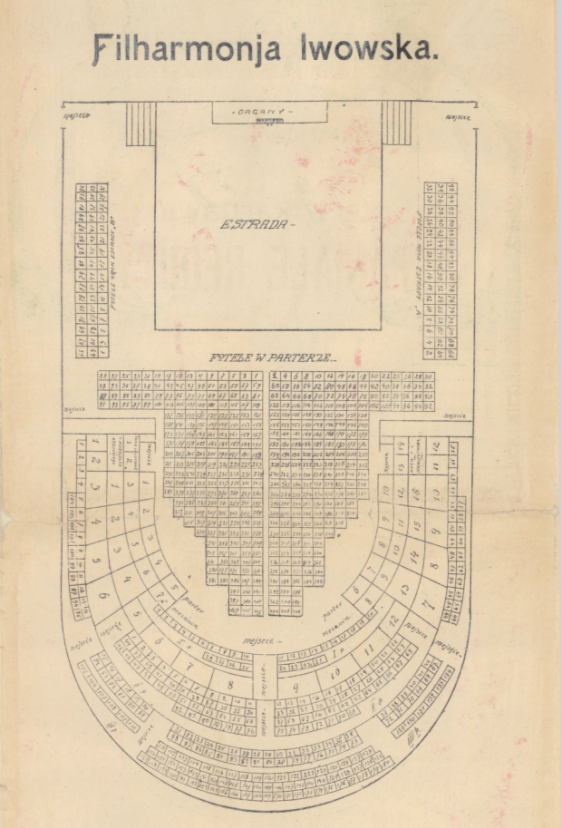
План залу філармонії у брошурі першого сезону
Starting in 1917, the Lviv Philharmonic revived its symphony concerts. They were performed by the military orchestras of the 33rd and 44th infantry regiments. These were large groups of up to 80 instrumentalists. The orchestras regularly gave symphony concerts during the 1917-1918 season (7 times) and performed only twice in 1918-1919. Most of these performances were led by Adam Soltys, a young Lviv musician, the son of the prominent composer and conductor, and long-time director of the GMS and the Conservatory, Mieczysław Soltys.
Between 1919 and 1939, the Symphony Orchestra of the Conservatory of the Music and Theatre Theatre remained virtually the only orchestra in Lviv that was constantly operating. Under the auspices of the Lviv Philharmonic and M. Türk’s Concert Bureau, a large symphony orchestra of the Polish Union of Musicians, organised in 1921 and consisting of 106 instrumentalists, performed from time to time (it united performers from the Polish Music Society and the City Theatre and worked until 1924). Its programmes were prepared by Bronisław Wolfsthal (1883-1944), Adam Soltys, Alfred Stadler (1889-1944), and Milan Zuna (1881-1960).
_____
[1] Mazepa L. The way to the Music Academy in Lviv. Lviv : Spolom, 2003. V. 1., P. 88
* Visual materials used from the Polish digital library “Polona”

